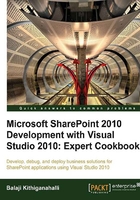
What this book covers
Chapter 1, List and Event Receivers: Event Receivers are used for responding to events raised by SharePoint on lists, features, list items, and so on. This chapter not only provides an overview of the event receivers that can be developed using Visual Studio 2010, but also guides you through the step-by-step process of creating them and applying them to real world scenarios.
Chapter 2, Workflows: In this chapter, you will learn about sequential workflows, site workflows, and deploying custom initiation forms with workflows using ASPX pages and InfoPath forms. You will also learn to create custom InfoPath task forms with the workflows.
Chapter 3, Advanced Workflows: In this chapter, you will learn Advanced Workflow topics such as creating custom activity for both sandboxed and non-sandboxed environments. You will not only learn how to create state machine workflows but also to model them. This chapter also guides you through the process of creating a Pluggable workflow service. Last but not least, this chapter also guides you through the process of changing workflow statuses.
Chapter 4, List Definitions and Content Types: In this chapter, we will discover the world of content types. We will use object models to create content types, add new columns, document templates, and workflows to content types using Visual Studio 2010. This chapter also guides you through the process of creating external content types that are linked to external data source such as the SQL Server database. In the end of the chapter, we will also learn how to create list definitions using Visual Studio.
Chapter 5, Web Parts: In this chapter, we will discover visual web parts, code-only web parts, AJAX enabled web parts, and Silverlight web parts. The chapter also provides details on connectable web parts and adding configuration properties to web parts. This chapter also provides detailed information on versioning and deployment of web parts.
Chapter 6, Web Services and REST: In this chapter, we will learn about using REST services to extract data from SharePoint. We will create client applications that make use of REST to extract data from SharePoint. We will also learn to create custom SharePoint WCF web services.
Chapter 7, Working with Client Object Model: SharePoint 2010 introduced the new Client Object Model which can be used to create client applications that use SharePoint as a backend data store. In this chapter, we will learn all the three client object models such as the managed object model, the JavaScript object model, and the Silverlight object model. We will also learn the exception handling techniques and asynchronous calling of these object models.